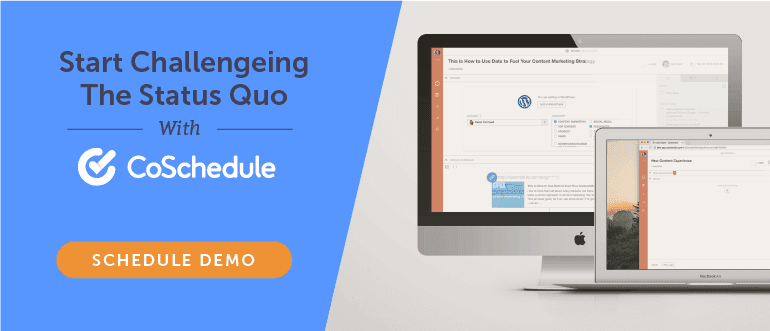Why Challenging The Status Quo Will Make You A Better Leader And How To Do It
 Challenging the status quo is about as inspirational as penguins walking on the beach.
Challenging the status quo is about as inspirational as penguins walking on the beach.
 Source: https://www.entrepreneur.com/slideshow/225879#2
^^^Oh yeah, that’s a thing.
Today, a call to challenge the status quo seems tired and played out…and honestly, what does it even look like?
Does challenging the status quo mean becoming an anti-establishment rebel? Or constantly pointing out the flaws in your organization? Or being the manager who “zigs” when everyone else “zags”?
Maybe so.
But what if challenging the status quo was something far more positive than negative…
...more exciting than intimidating?
All while actually being possible?
In this post, you’ll learn exactly:
Source: https://www.entrepreneur.com/slideshow/225879#2
^^^Oh yeah, that’s a thing.
Today, a call to challenge the status quo seems tired and played out…and honestly, what does it even look like?
Does challenging the status quo mean becoming an anti-establishment rebel? Or constantly pointing out the flaws in your organization? Or being the manager who “zigs” when everyone else “zags”?
Maybe so.
But what if challenging the status quo was something far more positive than negative…
...more exciting than intimidating?
All while actually being possible?
In this post, you’ll learn exactly:
- What’s at stake for you and your company if you don’t challenge the status quo.
- How to specifically identify your status quo and its impact in your organization.
- And a novel way to approach leading positive change in any context.
Why Challenging The Status Quo Will Make You A Better Leader And How To Do It via @CoSchedule
Click To TweetThe Positive Results Of Challenging The Status Quo
Right now, your Monday mornings might be packed with frustration, because your team is never on the same page, and no amount of communication seems to help. Anxiety may be constantly nipping at your heels because you’re worried your team will miss deadlines yet again. And your boss (or your boss’s boss) will be breathing down your neck, hawkishly watching for you to mess up, yet again. You’re stuck in reactive bursts, solving emergencies rather than steadily gaining ground on your quarterly KPIs. Not a fun way to live. Now, imagine if your Monday mornings became strangely (and wonderfully) different. What if they could look like this, instead? You roll into the office, sit down at your desk with a cup of coffee or tea, and dive into the week with purpose and energy. Your inbox isn’t flooded with questions like, “Where are we at with this project?” Instead, you have confirmations noting, “Brittany completed Y task.” You’re still riding high from last Friday afternoon, when you left the office after hitting every deadline for the week. Better still, you have complete confidence you and your team are heading for 100% completion across the board. There are a few fires that have sparked over the weekend that you need to snuff out (this is life, after all). But, happily, you have margin in your day to deal with emergencies. Instead of teetering on the brink of burnout, you actually got rest and unplugged over the weekend. Mondays are fun again because you aren’t filled with dread. The snooze button may as well not exist because you aren’t lying awake at night, mind racing about *that* project that’s gone off the rails. Best of all, you have the full trust of your boss and your team. They know you can lead them — and you even know you can lead yourself. You aren’t staring on with envy at all those other world-class marketers who get newsworthy results. Why? Because you are one of them.Can Challenging The Status Quo Really Get You Results?
Now, you may be rolling your eyes and calling B.S. on this new normal I’m describing. And while our workload as marketers is an average 72 hours per week and the load on our plates isn’t trending to get smaller, much of the above can in fact be realized. To start, your belief in both your position and your ability to lead change against the way things are is key. As the case studies by St. Edward's University in Why Great Leaders Challenge The Status Quo found: “... great leaders know that the path to exceptional growth and performance often requires upending existing ideas to choose a new path." This begins by clarifying a simple misconception about what the status quo actually is. We generally use status quo as a fancy-sounding way to describe the current state of affairs in a given context. However, if you’ll travel back to my freshman Latin class with me for some quick etymology, there’s something helpful for us to understand.What Is The Status Quo?
Status quo is a Latin phrase that means “state in which.” So we could rephrase it as: your status quo is “the state in which [your current outcomes/results happen].” [*As a quick side note:* I’d like to point out that my knowledge of a dead language has now proven professionally useful for the first time ever.] via GIPHY This means status quo actually describes the outcome the current state of affairs creates. This means status quo is best understood as a way of outlining the outputs generated by current inputs. So, to define the real status quo, it’s helpful to organize it into a statement structured like this: “Our current status quo is the state in which [current outcome] occurs is the result of [description of inputs].” For example: “The state in which [habitually missing deadlines] occurs is the result of [poor organization, unclear team priorities, and ineffective communication].” This way, rather being a nebulous term packed with negativity, it becomes an empowering exercise. This is because when you understand the causal relationships between our inputs and outputs, you can actually affect change. This is where your “Challenging The Status Quo” worksheet comes in handy.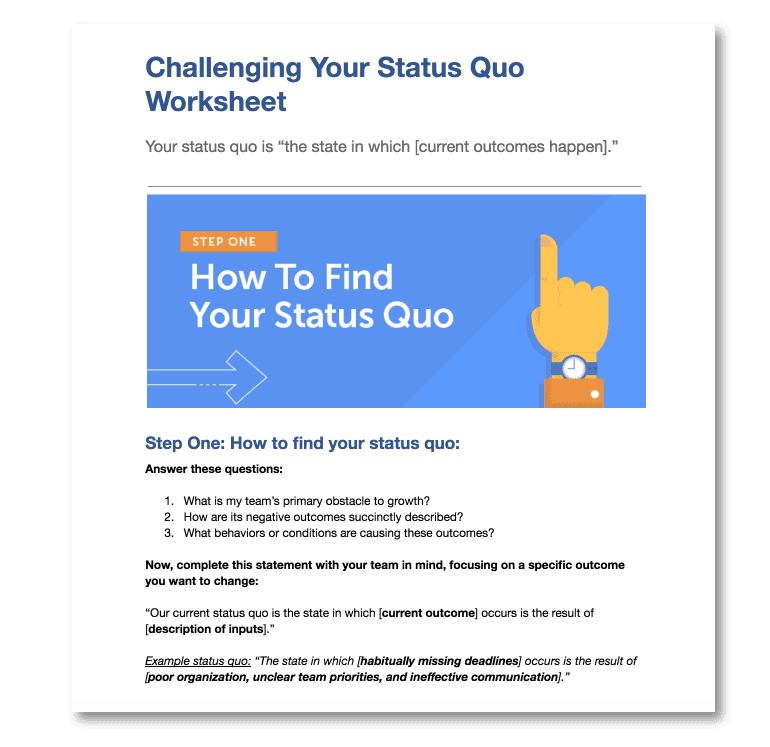 The first exercise is to find your status quo in a specific area. This is the current outcome you want to change, described in the actions, behaviors, or conditions that are creating it.
So answer these questions:
The first exercise is to find your status quo in a specific area. This is the current outcome you want to change, described in the actions, behaviors, or conditions that are creating it.
So answer these questions:
- What is my team’s primary obstacle to growth?
- How are its negative outcomes succinctly described?
- What behaviors or conditions are causing these outcomes?
!["Our status quo is the state in which [current outcome] occurs as the result of [description of inputs]."](https://media.coschedule.com/uploads/your-status-quo.png?w=3840&q=75) Once you’ve outlined your current “state in which,” you have the power to pinpoint plans for change.
Once you’ve outlined your current “state in which,” you have the power to pinpoint plans for change.
The Risk Of The Status Quo (AKA: Doing Nothing)
Now, challenging the status quo might feel risky—but it it’s likely far safer than staying the same. Did you know that maintaining the status quo will actually kill you faster than taking risks? We live in a “change or die” world. Marketing is exactly this way. And this is more than my anecdotal opinion. According to Kotter International: The “rate at which our world is changing is increasing, but our ability to keep up with it is not.”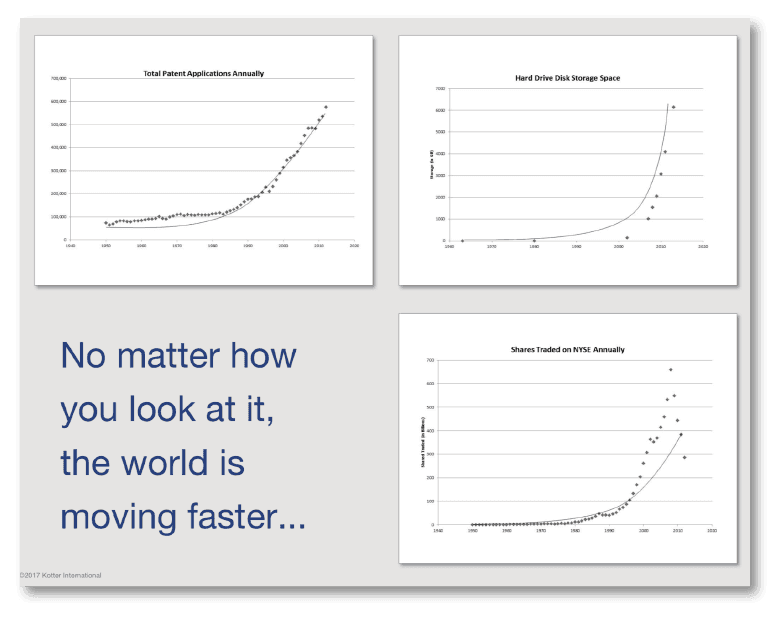 This plays true across every vertical—meaning marketing in every industry is included.
But the deception is that doesn’t feel like a risk to do the same things each week, does it?
How much risk is entailed in going to the same meetings? Generating the same reports? Running the same types of campaigns?
If you’ve always done it this way, it must be safe.
This is a flawed assumption. And it comes from underestimating the risk of the status quo.
A landmark article by Roger Martin, dean and professor of Strategic Management at the Rotman School, outlines the titanic costs that accompany maintaining the status quo.
Though he’s tackling the disastrous economic impact status-quo maintaining Canadian companies face, the principles are portable for our companies and teams as marketers.
Martin explains:
This plays true across every vertical—meaning marketing in every industry is included.
But the deception is that doesn’t feel like a risk to do the same things each week, does it?
How much risk is entailed in going to the same meetings? Generating the same reports? Running the same types of campaigns?
If you’ve always done it this way, it must be safe.
This is a flawed assumption. And it comes from underestimating the risk of the status quo.
A landmark article by Roger Martin, dean and professor of Strategic Management at the Rotman School, outlines the titanic costs that accompany maintaining the status quo.
Though he’s tackling the disastrous economic impact status-quo maintaining Canadian companies face, the principles are portable for our companies and teams as marketers.
Martin explains:
“The logic seems to be that, ‘since we are already doing what we are doing, it can’t be terribly risky.’ This, unfortunately, is a very flawed assumption.”Our Achilles heel is that we see something new as inherently risky, while something familiar is deemed safe. That the risk of doing nothing is greater than taking on something new. However, with the rate of change in marketing only accelerating, maintaining status quo is risky business. This brings us to the second exercise in your “Challenging The Status Quo Worksheet,” defining the risk of your current status quo. Define the risk of your current status quo. What bad things might happen if things don’t change?
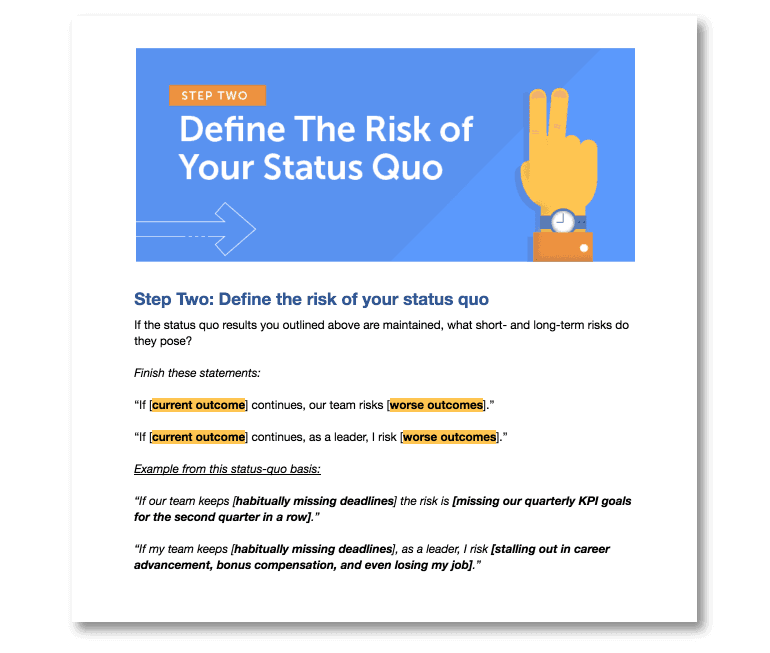 You will answer this question in two ways.
First, you’re outlining the risk of status quo for your team. Second, you’re being specific about the risk maintaining the status quo poses to you as the leader.
You will answer this question in two ways.
First, you’re outlining the risk of status quo for your team. Second, you’re being specific about the risk maintaining the status quo poses to you as the leader.
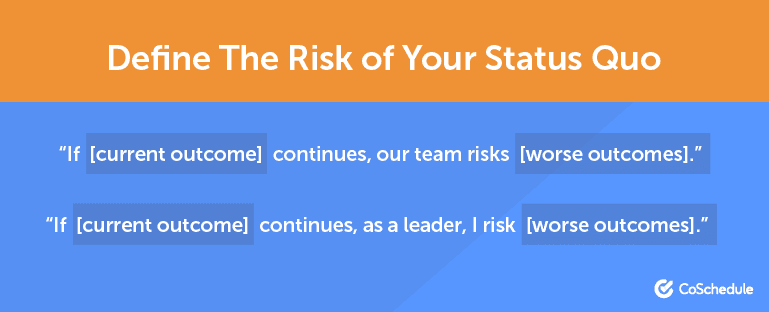 For marketing leaders, this exercise should create urgency in us.
Challenging the status quo actually means an honest evaluation of current results and the actions that have created them.
This is far more than touting change for change’s sake.
For marketing leaders, this exercise should create urgency in us.
Challenging the status quo actually means an honest evaluation of current results and the actions that have created them.
This is far more than touting change for change’s sake.
The Psychological Basis For Changing Your Status Quo
When we talk about the dynamics of change on any front — personal or organizational — we’re talking about modifying behaviors to impact results. While there are mega mindset shifts that need to take place, the real work is in changing behavior. Because knowledge does not equal change. If it did, we could change the world with a quick Google search. And millions of people would suddenly realize... “Oh, wow! All I need to do to lose weight is eat healthier and exercise!” ✓ Problem solved. “Smoking seems really bad for me. I’m sure glad I learned that. I guess I’ll quit. ✓ Poof...bad habit overcome. “Our team keeps missing our KPI targets because we haven’t hit a deadline in weeks. It’s so simple, let’s just hit our deadlines!” ✓ Results skyrocket. You’re instantly promoted. Obviously it doesn’t work like this. Just because we know the right things doesn’t mean we do the right things. The same holds true for individuals and teams alike. This means challenging the status quo will mean more than head knowledge. It’ll mean different actions than those that created today’s state of affairs. And this is precisely where your value and leverage enters the picture. Rather than being a peanut-gallery naysayer, you’re an internal engineer, building solutions to solve systemic problems (no matter how big or small).How To Lead Solution-Focused Change
Sure, there are deeper forces at work that influence our organizations… But this is a shortcut to faster results in the near future, rather than a months-long (or even years-long) battle to change the fabric of your company. This isn’t an exercise in, “How do we dredge up the slimy mess of what’s broken?” It’s a simple exercise in answering, “What actions, no matter how small, can lead to positive change right now?” This approach is well-supported by the psychological method called Solution-Focused Brief Therapy. The primary principle is to concentrate on finding solutions right now and mapping a quicker path to positive results. The main question these psychologists ask is: “If a miracle occurred while you were asleep tonight, what changes would you notice in your life tomorrow?” We’ll adapt it for our marketing context: “If a miracle occurred while you were asleep tonight, what small changes would you notice in your team tomorrow?” Go to section three in your “Challenging The Status Quo Worksheet” and answer this question with as much detail as you can.
You will use the specific status quo outcome you identified in the first exercise.
So, if we continue with the missed deadlines example, the small changes you might notice are:
Go to section three in your “Challenging The Status Quo Worksheet” and answer this question with as much detail as you can.
You will use the specific status quo outcome you identified in the first exercise.
So, if we continue with the missed deadlines example, the small changes you might notice are:
- My team would be sending me progress updates rather than begging for extensions.
- I would see notifications in my CoSchedule dashboard that tasks have been completed on time.
- My team would be clear on their priorities and finish the most important work first.
The Point Of Challenging The Status Quo In Your Specific Context
The main reason of challenging the status quo in such a surgical way has two parts. First, it helps you quickly pinpoint the actions that are generating the current results you want to change. For instance, if one of your team’s most important KPIs is qualified leads (which a study we conducted found is the main KPI pro marketers track), then you can reverse-engineer this poor outcome to its causes. Note, that these aren’t always giant, earth-shattering things, either. For instance, I work closely with our sales team to connect them with the best possible leads for CoSchedule. While we were working to optimize a specific tactic, we found out that the code had gotten wonky. This meant the process wasn’t working like it should, so people who were super interested in getting a demo of CoSchedule to save them the time of figuring out the platform in a trial were falling off… ...not because our copy was bad, but because the mechanism wasn’t working. After reducing the friction of poor user experience, “Voila!” Awesome marketers took the positive action we were inviting them to. Understand, then, that your status quo describes current results. And that your current results are driven by your current actions and behaviors. Pinpoint the sticky spots. Then map out a plan to fix them. You’ll likely find some easy wins that can make a huge impact along the way. Suddenly, the behemoth of “challenging the status quo” can get cut down to size. Second, it makes you a more effective, confident, and visibly successful leader. The leader who gets results is the leader who gets promoted. And new results come from new behaviors. Period. Not only will turning negative outcomes into positive wins make you look like a marketing genius, it will also give you crazy, Kanye-esque confidence. via GIPHY Scientifically stated: confidence is "the degree to which you think and ‘feel’ your actions will achieve positive results." When you make wins happen, you know you’ll be able to do it again… and again… and again.The Crux Of A Toxic Marketing Status Quo: Makeshift Marketing
At CoSchedule, we talk with millions of marketers each year. And through these experiences, we’ve identified the primary creator of a negative marketing status quo… We call it makeshift marketing—and it’s the hidden cause of myriad issues. The modern marketing stack makes staying organized hard. And the reality is that today’s marketing landscape is flooded with single-function tools. Marketers are log jammed with planning tools, social stack, tools for content marketing, and then productivity tools that manage her team. And, none of them play well together. What this means is many of the teams we talk to end up adopting a variety of tools just to get their work done. They’ll use one tool for social, and another for task management, and then before they know it they end up adding a spreadsheet to the mix to TRY and tie it all together… Often, it ends up looking like this: ^^^ yes, those are actual pics marketers have sent us over the years.
The result is a status quo that results in:
^^^ yes, those are actual pics marketers have sent us over the years.
The result is a status quo that results in:
- Extreme frustration that your team can’t stay on the same page,
- Uncertainty about where projects are at,
- Lack of visibility into all of your marketing,
- Distrust and doubt in your team’s (and your own) ability to get the results you’re on the hook for,
- And honestly, lackluster results even though you know you’re capable of more.
 Now here’s some fantastic news… You can plot a path to beat makeshift marketing and its rotten results in 30 minutes or less. And there’s a 99% chance you can do so today!
Schedule a personalized, 1-on-1 demo and discovery with a CoSchedule expert to challenge and overcome the negative status quo impacts of makeshift marketing.
Now here’s some fantastic news… You can plot a path to beat makeshift marketing and its rotten results in 30 minutes or less. And there’s a 99% chance you can do so today!
Schedule a personalized, 1-on-1 demo and discovery with a CoSchedule expert to challenge and overcome the negative status quo impacts of makeshift marketing.
